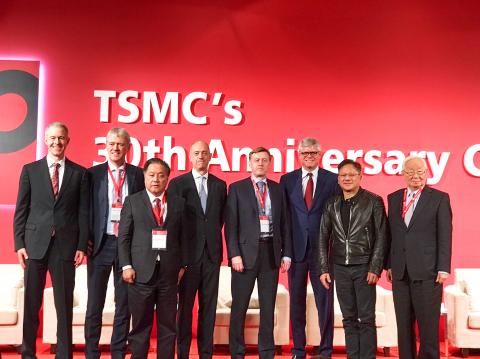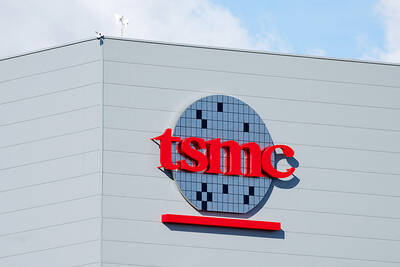Apple Inc is grateful to Taiwan Semiconductor Manufacturing Co’s (TSMC, 台積電) capital investment of US$9 billion in the Taiwanese firm’s first initiative with Apple to supply all the processors used in iPhones and iPads, Apple chief operating officer Jeff Williams said yesterday.
Williams made the remarks at a panel discussion in Taipei organized by TSMC as part of a series of activities celebrating the 30th anniversary of the foundation of the world’s biggest contract chipmaker.
Williams did not specify which iPhone he was referring to.

Photo: Hung You-fang, Taipei Times
“TSMC invested US$9 billion and had 6,000 people working around the clock to bring up the Tainan fab in just 11 months, and in the end, the execution was flawless,” Williams said. “Companies in the world spent US$9 billion in capital across everything, not a single bet.”
In that short period of time, Apple and TSMC together shipped more than 500 million chips, Williams said.
However, the first seed of the partnership between Apple and TSMC was planted in 2010, the Apple executive said.
TSMC’s leading technology position and its long-term strategy of being the trusted capacity supplier for semiconductor companies helped it secure the first orders from Apple, beating rival Samsung Electronics Co.
“We want leading-edge technology, but we want it at established technology kind of volume,” Williams said. “And what seems obvious right now wasn’t then because the risk was very substantial.”
For TSMC, it was a huge capital investment and meant ramping up production faster than the industry is used to, Williams said. “But, together, we decided to take the bet... Apple decided to have 100 percent of our new iPhone and new iPad application processors sourced to TSMC.”
TSMC chairman Morris Chang (張忠謀) said the company’s partnership with Apple has been intense and is important, even though it did not go back very far.
TSMC is still the sole chip supplier for Apple’s latest A11 Bionic chip used in the latest iPhones.
To produce and develop advanced process technologies such as 7-nanometer and 5-nanometer chips, TSMC budgeted a record capital expenditure of US$10.8 billion this year, and its annual budget is to stay above US$10 billion over the next few years.
Chang yesterday gave a bullish outlook about revenue growth in the global semiconductor industry.
He predicted that the industry will post a compound annual growth rate of between 4.5 and 5.5 percent in the next decade, exceeding global GDP growth.
TSMC will outgrow the global semiconductor industry as it aims to increase revenue by between 5 and 10 percent a year, he said.
Broadcom president and chief executive officer Hock Tan forecast that the industry’s growth would match the global GDP growth, which could be in the range of between 2.5 and 3 percent a year.
Answering an analyst’s question about when Moore’s law will come to an end, Chang said that the original version of Moore’s law is no longer valid, as it has a time element.
“The doubling of density is continuing, but not every 18 to 24 months [as the law says],” Chang said.
The economic feasibility of density doubling will be tested in 2025 before geometry shrinking reaches its physical limit, Chang said.
TSMC will continue to work on density doubling for another eight years, Chang said.

Taiwan Semiconductor Manufacturing Co (TSMC, 台積電) secured a record 70.2 percent share of the global foundry business in the second quarter, up from 67.6 percent the previous quarter, and continued widening its lead over second-placed Samsung Electronics Co, TrendForce Corp (集邦科技) said on Monday. TSMC posted US$30.24 billion in sales in the April-to-June period, up 18.5 percent from the previous quarter, driven by major smartphone customers entering their ramp-up cycle and robust demand for artificial intelligence chips, laptops and PCs, which boosted wafer shipments and average selling prices, TrendForce said in a report. Samsung’s sales also grew in the second quarter, up

LIMITED IMPACT: Investor confidence was likely sustained by its relatively small exposure to the Chinese market, as only less advanced chips are made in Nanjing Taiwan Semiconductor Manufacturing Co (TSMC, 台積電) saw its stock price close steady yesterday in a sign that the loss of the validated end user (VEU) status for its Nanjing, China, fab should have a mild impact on the world’s biggest contract chipmaker financially and technologically. Media reports about the waiver loss sent TSMC down 1.29 percent during the early trading session yesterday, but the stock soon regained strength and ended at NT$1,160, unchanged from Tuesday. Investors’ confidence in TSMC was likely built on its relatively small exposure to the Chinese market, as Chinese customers contributed about 9 percent to TSMC’s revenue last

With this year’s Semicon Taiwan trade show set to kick off on Wednesday, market attention has turned to the mass production of advanced packaging technologies and capacity expansion in Taiwan and the US. With traditional scaling reaching physical limits, heterogeneous integration and packaging technologies have emerged as key solutions. Surging demand for artificial intelligence (AI), high-performance computing (HPC) and high-bandwidth memory (HBM) chips has put technologies such as chip-on-wafer-on-substrate (CoWoS), integrated fan-out (InFO), system on integrated chips (SoIC), 3D IC and fan-out panel-level packaging (FOPLP) at the center of semiconductor innovation, making them a major focus at this year’s trade show, according

DEBUT: The trade show is to feature 17 national pavilions, a new high for the event, including from Canada, Costa Rica, Lithuania, Sweden and Vietnam for the first time The Semicon Taiwan trade show, which opens on Wednesday, is expected to see a new high in the number of exhibitors and visitors from around the world, said its organizer, SEMI, which has described the annual event as the “Olympics of the semiconductor industry.” SEMI, which represents companies in the electronics manufacturing and design supply chain, and touts the annual exhibition as the most influential semiconductor trade show in the world, said more than 1,200 enterprises from 56 countries are to showcase their innovations across more than 4,100 booths, and that the event could attract 100,000 visitors. This year’s event features 17